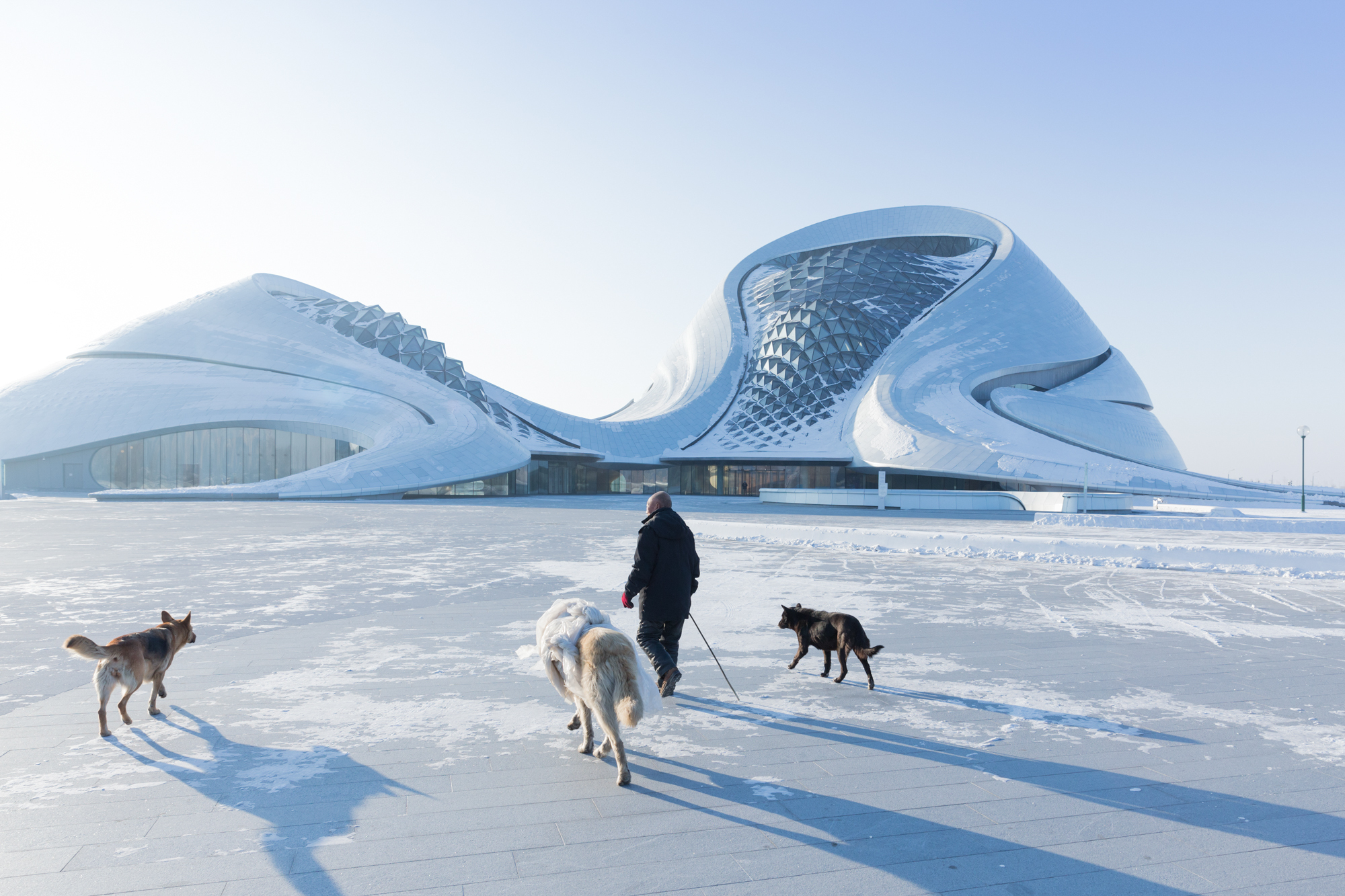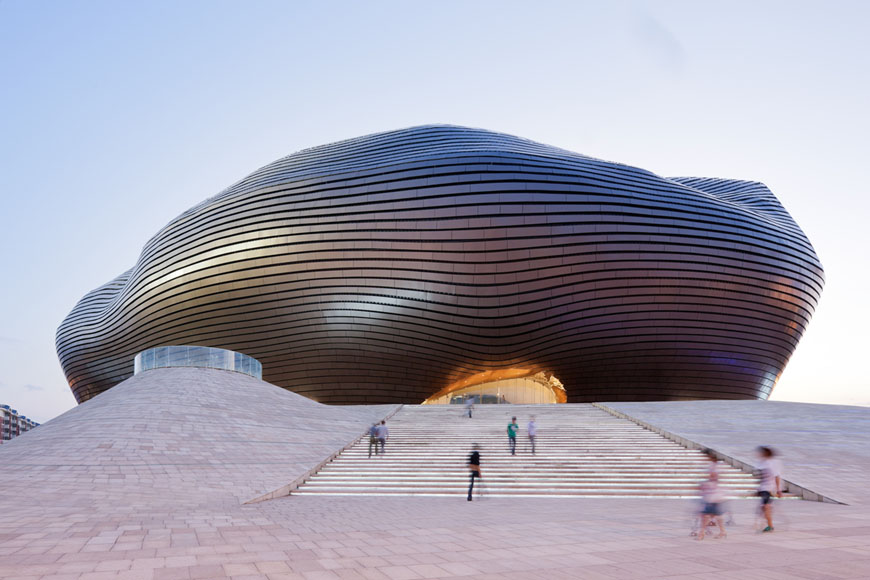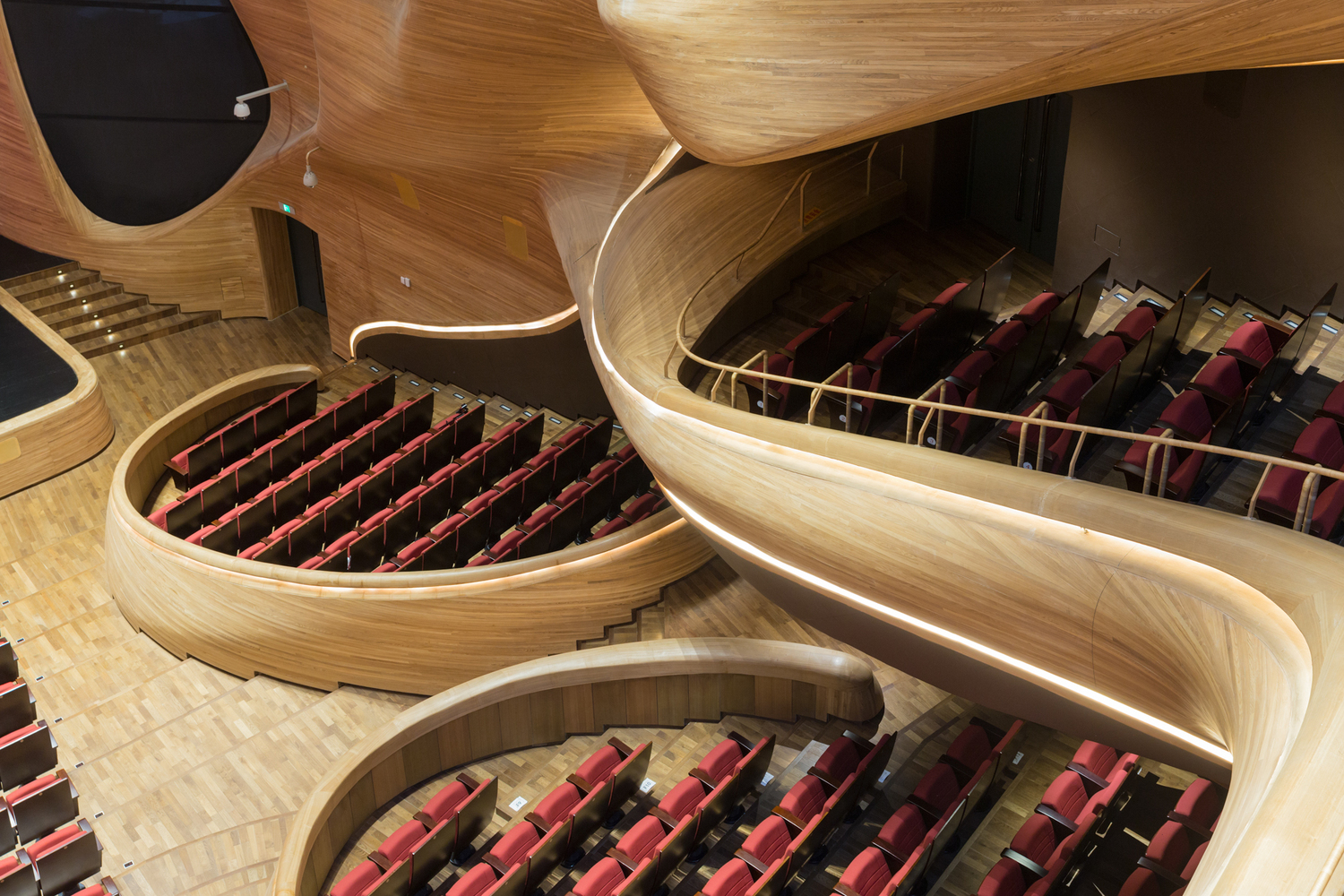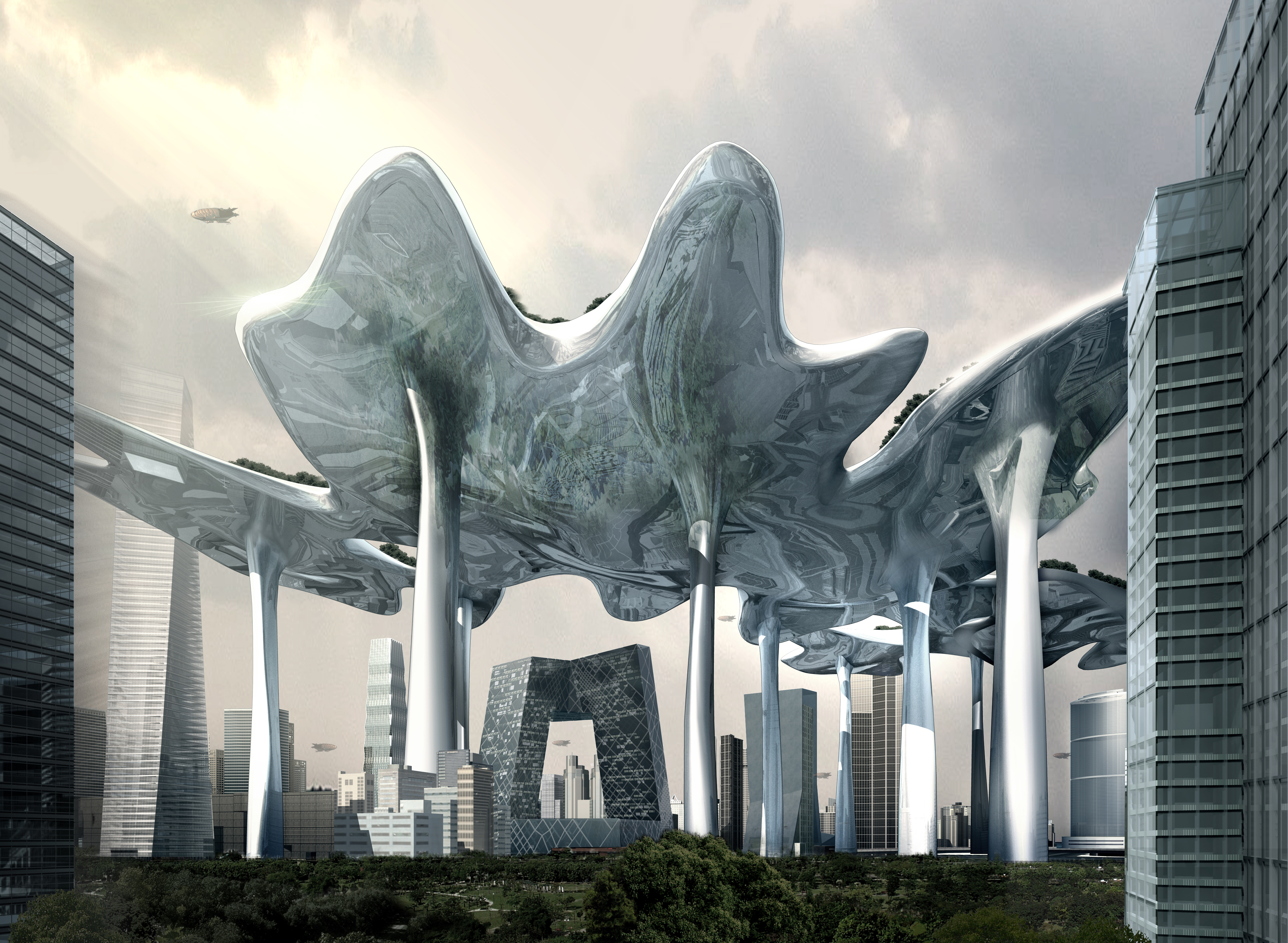An interview with Ma Yansong

Harbin Opera House. Harbin, China. 2015. Photo: Iwan Baan.
In the 80s, the exiled Chinese rocket scientist Qian Xuesen envisioned a more humane form of development that would integrate nature with urban life. He called it “Shanshui City,” after a style of landscape painting that arose in China in the 5th century. Today, this utopian ideal has been invigorated and substantiated in the practice of Ma Yansong, who, as founder of MAD Architects, has spent the last fifteen years orchestrating a harmony of the natural and the manmade. From his residential buildings outside Toronto (known as the “Marilyn Monroe” towers for their shapely curves) to his Harbin Opera House, an undulating sculptural form that disappears into the city’s snows and marshes, Ma’s architecture rejects rationalist, modernist tropes in favor of expression, intuition, and emotion.
Ma was born in Beijing in 1975. Two years after graduating from Yale, he set up his own practice, competing with — and winning commissions over — such former mentors as Zaha Hadid. On a cold November day, less than 36 hours after the US presidential election, I met Ma at his hotel in SoHo. He’d just flown in from Beijing to oversee the expansion of MAD’s New York office, and had stayed up all night watching the returns. All across the city the mood was somber, but as we sat on a banquette in the empty hotel bar, it became clear that Ma was not one to dwell. Though jetlagged, he spoke fluidly and insisted on addressing the future. Not content with merely four years, he was already imagining decades, centuries ahead.
—Lynette Lee
You grew up during a time of economic reform and unprecedented growth in China, when Deng Xiaoping’s Open Door Policy helped drive foreign investment and domestic entrepreneurship. What that was that like for you?
I grew up in a hutong courtyard house, in a traditional Beijing neighborhood. I remember when I was around ten, new buildings were being built in the city. These buildings were very simple: they were six-story brick walk-ups with white paint and concrete floors. Not much decoration. But everyone wanted to move into the new buildings because they were cleaner, they were a little bigger, and most importantly they had heating in the winter. In the courtyard houses, you had to burn coal, which was dangerous.
So that became a symbol of modern life — moving into the new concrete towers. The buildings got taller and taller and you started to see ten-story buildings. Twenty-story buildings. And even at that height, they were still very low budget, so the whole tower only had one elevator, and the elevator could not afford to stop at every floor; otherwise it would wait too long. So it stopped every few floors. Afterwards, you would walk to your own unit.
It seems like a familiar Chinese tale: the old being cleared to make way for the new. Did you have any impressions of the old architecture when you were young, though? Any fondness for it?
When I was studying architecture, our mayor at the time said we should fight for our old Beijing, because the city was becoming too modernized. This was in the 90s. He suggested that all the new buildings should have some visual elements of ancient Chinese architecture. After that, if developers needed approval from the city for a building design, they would show the model of a modern tower and keep a model of a miniature pagoda roof in their pocket. If the modern building wasn’t accepted, they put the pagoda model on top of the modern model, and then it would get approved. This made for a lot of ugly buildings in Beijing.
So there were no good examples of harmonizing the old and the new. When I was a young student, all I saw was the poverty of the old courtyard houses — no heating, no hot water, toilets in the courtyard—and the ugliness of the new buildings.
I only started to experience more of the Open Door Policy after Yale, around the time of the Olympics. Many architects came and brought their designs to Beijing. Although there was some criticism that Beijing had become a “lab” for international architects, personally I felt that to create a great city, the city had to have a lot of new, serious architecture.
Around that time, I also started to see the value of the old buildings. The key moment was after I moved back to Beijing. I tried to find where I had lived before, which was near the Wangfujing area. When I went there, I saw shopping malls all around the hutong. I went inside my old building, and since I was a trained architect now, I thought to myself, “Oh, this is a good size. This is a good scale. It’s very human — there’s a big tree in the courtyard.”
I started to realize that architecture was not just about providing space, but also about providing quality in the way you live. After two or three months, I tried to go back again, but the courtyard was already destroyed. There were a few parking lots around and all of the courtyards had been razed to make room for a shopping mall. It made me feel very bad.
Now there are fewer and fewer courtyards in the whole city. Back then, I didn’t really care. Nobody thought we were destroying anything of value — nobody cared. But now we look back, and we realize what we have lost.

I wonder if destruction informed your early work as much as construction: the destruction of the courtyard itself, the continued erosion of the city...
After I came back from the West, I began to see the uniqueness of Beijing. Like Jingshan Park, where you can look around and see the whole city. Houhai [a manmade lake in Beijing] is where everyone learns to swim. In Houhai, there’s a stone bridge and when you’re on the bridge, you can see the mountains from very far away, and their reflection in the water. It brings the mountains, which are outside the city, into the city.
All of this—the parks, the residential areas, the commercial areas—coexist in the city center. I feel that it’s very different from western cities. You have this, shall I say, “enlarged garden” as an urban center, and people live there. Everything is in the center, and it’s all artificial. You are living in an urban environment, but it feels like you’re in nature or a village.
I didn’t realize its uniqueness until I had a point of reference, after I had come back. I started to think, actually, in my architecture, I like nature a lot. I didn’t grow up in a super urban environment. In my eyes, nature and urban environments always mixed.
And you make a real effort to dictate landscape design, as well.
I was struggling this morning, actually. There’s one project — the building is almost finished — and I wanted the developers to put in three times the number of trees than they were used to. But they don’t want to — it costs them more money.
Nature is always the easiest cost to cut. Does its removal call into question your idea of a building’s success? Or a final site’s beauty?
Beauty is often very relative; some people will think something is beautiful, others will not. What I think is, it’s not only about beauty, but it’s also about how a building performs over time. In five generations, a hundred years, people will have a different understanding of the building. The story you’re telling at the beginning, people won’t know or care in a hundred years. What they feel is the physical space. And when they visit, they will have an emotional reaction to the place. Like the gardens in Beijing, for example. Now, when I go, I still feel the vibrancy, the cultural heritage of the place. Their beauty and value lie in their timelessness.
I also think, for the current generation, as a public space, it’s important to make a building engaging, to invite people to come. Landmark buildings may look great but they isolate themselves from people. What’s important is for people to appreciate the building and for it to be friendly and approachable.
Granted, the exterior of a building is critical, but do you prioritize programming at all? Do you give serious thought to a building’s utility, or content?
I don’t worry about that, I think it’s only a matter of time. I think building a beautiful building before you have a collection is a great thing. It means you’re really looking for something. It’s better if you have no collection than if you have no building. Prioritizing a building over its collection or content gives architecture a deeper social meaning, because it’s a public space first, for the people.
We built an opera house in Harbin, and at the very beginning the government had no requirements. They just wanted a performing arts space and an opera house like any other. But I was thinking, while an opera house is normally used in the evening, people also might want to visit during the day. So we designed an open wrap on the building façade to look like a big art piece, a sculpture. It looked like a part of the landscape, a snowy mountain you could literally climb.
It became so popular. Every day, so many people visit now. They like to climb, and they want to go to the top and look around. People take pictures, send them to friends, and the images are on social media everywhere. People from western countries, even. It was on CNN! We won many awards, and it made local residents feel more excited and think, “This is how great architecture changed our city.”
But is that enough, if nothing is going on inside? It’s a pretty expensive selfie backdrop if there’s no performance.
Everyone thought we would die. Everyone thought that the opera house was beautiful, but what if there are no shows? Well, this year we had 300 shows in the opera house, and in the last couple of weeks, we had War and Peace, a production from the Mariinsky Theatre. Six hundred performers came from Russia, and Putin wrote a letter to President Xi praising the opera’s first Asian performance.

The Harbin Opera House, like so many of your works, is informed by a certain artistry: fluid lines, curved spaces, sinuous forms. What is the relationship between art and architecture in your practice? Would you say that more than an architect, you’re an artist who designs buildings?
I believe architecture is art. I’m not a good artist, but I used to do traditional painting—shanshui painting, which is a way of depicting a purely imaginary experience. It’s not as if you draw something according to the eye. You don’t trace a landscape. You can draw very strange things and you can call it a mountain, a cloud, a storm, whatever. It’s a pure expression of a feeling, an experience. The painting becomes a medium to express your idea of nature to other people.
I find that architecture is very similar. You create the environment. This environment becomes the medium and you’re behind the scenes, the way an artist is behind their work. I enjoy this a lot. I enjoy working alone, quietly, but I also enjoy seeing how the public receives your creation. How they behave. If they hate it, or like it.
Now that many people have liked it, and you’ve become increasingly successful, you’ve courted some controversy as well. One of the main criticisms is that your work is similar to that of your former mentor, Zaha Hadid. Three months before she passed away, she said in an interview in the Chicago Tribune, “He’s obviously very fond of me. He remembers me on every project.” She went on to equate your design for the Lucas Museum in Chicago to her Dubai Opera House, “but with a halo on it.”
Really? Because she lost! She was in the competition and she lost. No, I think there’s a different meaning. She was my professor and she really liked to push me. If I weren’t a good student, she wouldn’t have even bothered mentioning me. Zaha lost the competition so she had to say something! What other people criticize, though, is different. Those people were also criticizing Zaha. I think as her student, there’s nothing wrong with my work looking similar to hers. I don’t have to deny that. There are other architects doing work that looks similar to Le Corbusier or Mies van der Rohe. They all look the same. Nobody criticizes them.
What’s important is that the origin of the works is different. Zaha’s work comes from early Russian abstract paintings. Later on, she switched from sharp corners into a more fluid architecture, maybe because of the influence of the Middle Eastern tradition.
Patrik Schumacher, Zaha’s partner and now principal at Zaha Hadid Architects, coined the term “parametricism” to describe a kind of algorithmic design. He sees this as a global convergence in architectural style, and the successor to modernism. I think he would say too that your work, in many ways, fits into his philosophy.
No, no, no. In the beginning he did, but after I rejected this term many times, he no longer invites me to his conferences! Every time I go there I say, “I’m not parametric, I don’t understand what this is.” I think he mixes the methodology with the philosophy. He’s a guy who executes, he makes buildings for Zaha. Zaha was an artist who could not express herself. She’d never say, “What is my philosophy?” She was making art or creating, and he, Patrik, tried to make those art pieces into buildings. Parametricism probably became the tool to realize those buildings. But a tool cannot be a philosophy. This was not Zaha’s intention at all—she was a very emotional person. She liked to create new things, and she trusted instinct.

As for yourself, you’re always being presented as a Chinese architect with an eastern philosophy. Do you ever feel the burden of this portrayal or designation?
I don’t care. I think it’s important for myself to know who I am. When I wrote Shanshui City, it wasn’t as a public statement. For me, Shanshui is an experiment. I find a connection to the past, to tradition, to what I understand about the history of China in my work. It’s a process for me to understand myself.
Every time I hear people talk about tradition, they fail. I mentioned the tower and the pagoda roof earlier, because in China many people in this process of modernization have a crisis of identity. All they can do is keep copying or accepting what they believe to be modern. But the fact is, if you don’t have an origin you will always be stuck.
For me, it’s important to go beyond what we know as modern. I need to know who I am, so I gather knowledge from the West and East, and with this, I try to create for the future.
You’ve been to New York many times: a place that thinks of itself as a big city, but is in fact much smaller than Beijing. We have our own urban garden...
I think New York is a great city because of Central Park. Without Central Park, there are too many buildings. You can see the difference between Central Park and central Beijing, though. Beijing also has nature in the middle, but there’s a more of a mixture. That kind of nature I’m talking about also embodies cultural values. In Japanese dry gardens, for example, you don’t even see green, it’s a set of rocks. But the rocks reference the universe and the ocean and people’s lives—
Zen.
Yeah, exactly. It’s beyond what you see. Beyond the physical and material. What’s missing in the architecture of modern cities is that even now we’re talking about greenery, trees, and public space, but we’re not talking about the emotional. If all the cities in the world have enough green space and public space, they will all look the same!
All these new buildings, for instance, are LEED-certified and save energy. Who cares? Maybe it’s criminal to assume we’ll have energy shortages in the future; maybe we’ll have too much energy, I don’t know, too much sun in the future! The point is: this is where you begin to treat architecture as a product. You think conserving energy makes for a great building, but still, people in that office building will feel no different from people working in an office building from the 90s. It’s just the same organization of space. After work they’re still looking for another world to go to, an escape. A zero-energy building won’t necessarily bring the people who work there happiness or enjoyment.
So what do you intend to provide, then, beyond reduced carbon emissions? A sense of calm, a sense of peace?
No. Some gardens make you think that way, because they’re private. They’re very intimate. But Beijing and Hangzhou, Nanjing, they’re the result of large-scale urban planning. The mountains in the city, the green, public space: these spaces are public, they’re about people. Different people, of all ages and backgrounds, can enjoy them—and no matter who you are, you can go there and feel beauty.
This philosophy of openness has to be embedded into public urban planning, so that you can feel what’s around you without intellectualizing what you are experiencing. When I was young, all I knew was that I enjoyed fishing in the water, swimming in it. Now I can say what I’m saying and draw it into Shanshui City because this physical world has become a cultural context and influenced me.
It’s important to create a cultural context for a lot of people growing up and living in China now, who don’t have that sense of identity. Or who have a confused identity, because the past has been erased and all that’s left are facsimiles of Western aesthetics and ideals.
I think ancient values are very advanced and can be very inspiring for the future. When I was younger, I never talked about tradition. Then, when I went back to China, I didn’t have an opportunity to make buildings yet, and people were criticizing my designs. They said they were too much like “paper architecture,” where you draw something that never gets built. So in magazines and interviews, I would say, “I’m waiting for all these old people to retire, so I can have my space.” I think they’re very conservative. My image is more about the future.

Speaking of the future: ten years ago, you drew up a design for Beijing in 2050 and proposed that by then, “a mature and democratic China will have emerged.” Do you still believe that now? What keeps your optimism alive?
I don’t know. Personality, I think—compared to some other architects, I’m not as pessimistic. But also I realized that we are already entering a different era, a post-industrial time. That’s why I, instinctually, don’t like grand buildings. I don’t want a monument. I want to make things more free and natural, to make a tower look curved and soft and rounding off at the top. I say to myself, “All the other towers look super strong. They all look like a man.”
But does it still make sense to think as far ahead as 2050? Even in China, the political and economic situations are not the only barriers to progress; there’s the ecological situation too, the endemic pollution...
In my Beijing 2050 project, I had a proposal to make Tiananmen Square into a forest. I found a historical photo of Tiananmen, which used to be wooded before they cleared everything to make room for the plaza. It would be difficult to realize that proposal, but now they have two large patches of grass, and I already think the place is transforming and becoming more human. So now I have a different dream.
Beijing is getting so big now, with so many people. Right now, unless you are right in the center of Beijing, you don’t know where you are. The city has no character. But old Beijing was a garden — I have to say an Eastern garden, where artificial nature and artificial buildings co-existed in the same scenery. What if we apply this philosophy to the overall city? If the city’s future urban plan can adopt the old philosophy of Beijing’s center, I think it will be the greatest achievement of this generation.
That’s a big thing, and I don’t think that we can realize that in full. For Tiananmen Square, once somebody in power says yes, then we can do it overnight, but for the whole city, it will really take a long time. And yet these days we often talk about great cities from 159 the past, but we’re not creating anything. Everything has become so commercial, and there’s not much looking forward. If you compare architects of this generation with those from a couple of generations before, it’s very different. Younger people are looking for small-scale success rather than designing for the future.
What about here in the US? We’re entering into a very dark time here. Is there something that architecture can do for us, in this context?
Yeah, of course. What’s beautiful about architecture is that it takes time. Politicians have four years, but any architecture project takes longer than four years. When you see something built, the architect probably had the idea ten years ago. That’s normal. He has an idea and the idea matures; he proposes something and somebody accepts his idea; it takes another five years to build it and then people finally get to see it. Four years is nothing—you can look forward and create for the future.
For architects, they have to know they’re responsible to the future. Fifty years later, nobody cares how tough your situation was. They only look at your building. If you make trash, it will disappear in the next ten years. You have to think about what’s right for the future, and keep doing that. Even if you have no resources, just keep proposing. I think sometimes a difficult time is a good time.